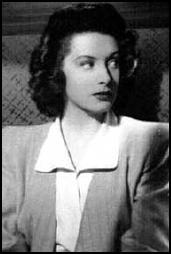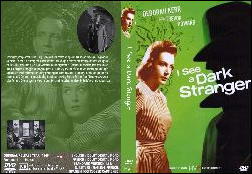Thu 14 May 2009
Movie Review: I SEE A DARK STRANGER (1946).
Posted by Steve under Reviews , Suspense & espionage films[5] Comments
I SEE A DARK STRANGER. Individual Pictures/General Films, 1946. US title: The Adventuress. Deborah Kerr, Trevor Howard, Raymond Huntley, Norman Shelley, Garry Marsh, Tom Macaulay. Director: Frank Launder.
This one was an eye-opener, I’ll tell you that first. In spite of From Here to Eternity, I’d always thought of Deborah Kerr as being the epitome of the pleasant matronly type, even when she was too young to be a matronly type. But when she herself was young, she was a shy but determined spitfire, or at least she could play one, as her role in I See a Dark Stranger most definitely shows.

And in spite of being Scottish by birth, she could also play a young unsophisticated Irish lass so filled with hatred toward the British that when she was 21, she could travel alone to Dublin from her small village and ask to be signed up to fight them — not realizing that during World War II, Ireland was not exactly fighting the British.
You noticed the qualification in that last sentence, I’m sure. To appreciate this movie more, you’d have to know that in World War II Ireland was officially neutral, and the Nazis had somewhat realistic hopes of using the enmity between the two countries to their own ends. (See my review of The Private Wound by Nicholas Blake for a mystery novel that also uses this small but hardly insignificant bit of history as its backdrop.)
Turned down by an old comrade of her father’s in the continuance of her cause, Bridie Quilty turns to a German spy named Miller, played by Raymond Huntley with much worldly panache and aplomb, the cigarette in his mouth bobbing up and down in his mouth as he speaks as if it were alive and trying to escape.
Fatally attracted to her, however, is Lt. David Baynes (Trevor Howard), who follows her clear across England and back to Ireland, hoping to (first of all) discover why she is acting so strangely — having to dispose of a dead body in the middle of the night will do that for a girl — and then try to extricate her from the troubles she finds herself up to her pretty neck in.
Back when there was a long discussion on this blog about the definition of noir when it comes to films or books, a question was asked whether there was a satisfactory combination of noir with screwball comedy in the same movie. The Big Clock comes close (reviewed here), but here is another one.

Or at least it is if two conditions are satisfied. First of all, that there are sufficient dark and sinister elements in this film that it could be actually be called noir. It’s currently described that way on many blogs, including Steve-O’s Noir of the Week blog, but I’m not so sure. It’s borderline at best — nor do I think the comedy is of the screwball variety.
And this is where the movie went off the tracks, as far as I was concerned. The ending is pure slapstick, with pratfalls into a bathtub the highlight of all of the happy hijinks of the final reel. Till then, though, up to the point where both Bridie and Lt. Baynes are captured by German agents, it’s an exciting tale of espionage laced with humor, with the latter emphasized by Bridie’s complete wide-eyed seriousness. She’s determined to fight the British, and nothing will stop her.
Strangely enough, she doesn’t have red hair. It’s brown, and she’s young and naive, and she has blue eyes, and if nothing else, she’s a sight for sore eyes, that is for sure. The large ensemble of British movie actors and actresses behind her, a stalwart group indeed, only adds in making this a very entertaining film, noir or no. (And make that whether the ending matches the rest of the film, or not.)
May 14th, 2009 at 10:51 pm
I don’t think you can call I See a Dark Stanger noir by any stretch of the definition (or slapstick), but it’s a fine film that may be best defined by the term ‘droll.’ Droll was a specialty of director/writer Frank Launder, especially when he teamed with Sidney Gilliatt for films like Green For Danger, State Secret, The Green Man, Belles of St. Trinians, and screenplays for The Lady Vanishes and Night Train to Munich, almost all of them a mix of comedy and mystery that is uniquely British and the teams signature.
As for that slapstick ending to I See a Dark Stranger I suspect that the screenplay ran head-on into wartime reality, a touchy subject even four years after the end of the war. Irish neutrality and flirtation with the Nazi’s was a touchy subject considering the number of Irishmen in the British army, not to mention the Commonwealth nations and the US. After flirting with the subject the movie wisely chose to get itself out of trouble by going for a laugh. It was a somewhat ham handed attempt to dismiss the whole Irish flirtation with the Nazi’s as being something of a joke, a nod to theatrical Ireland as opposed to the real thing.
The subject is touched on a little in Ronald Neame’s The Man Who Never Was with Stephen Boyd playing a ficticious Irishman working for the Germans and a recurring character in Jack Higgins novels is an Irish revolutionary who works for the Nazis. Donald Sutherland’s Nazi agent in Eye of the Needle is Irish too. Who was on whose side and when they made the decision is still a touchy subject.
May 14th, 2009 at 11:00 pm
David
That’s an explanation that hadn’t occurred to me, I admit, but it makes a lot of sense. The ending was rather jarring, I thought, but as I said in the review, sometimes when you watch old films, or even new ones, a sense of history can come in awfully handy. Reading behind the scenes to pick out reasons why this and not that is always fascinating.
And of course what this does for me in regard to Dark Stranger is to warrant another watching!
— Steve
December 17th, 2011 at 9:59 am
I just got around to seeing this excellent film and despite being including in the book, BRITISH FILM NOIR, this movie is not noir. It’s a spy drama with elements of comedy.
One odd scene that I found to be of great interest was the clip showing a large amount of horse drawn taxis in the streets of Dublin. This was 1944 and yet it looked like 1844 and Dublin was by far Ireland’s biggest city. A great scene.
December 17th, 2011 at 10:34 am
Thanks for keeping this old review in mind all this time, Walker. It’s a good thing I’d written the review, as I’d all but forgotten the movie.
But it all came back to me as soon as I read the review. I suggested in Comment #2 that I might watch the movie again, but obviously I didn’t (and I should).
I’m glad you agree it’s an excellent film. It really has a lot going for it.
May 5th, 2015 at 8:59 am
I loved this movie. I agree it’s no noir, but it has some nice noir elements throughout. It needs to be seen more than once, I think, if only to get the geography straight in my mind.